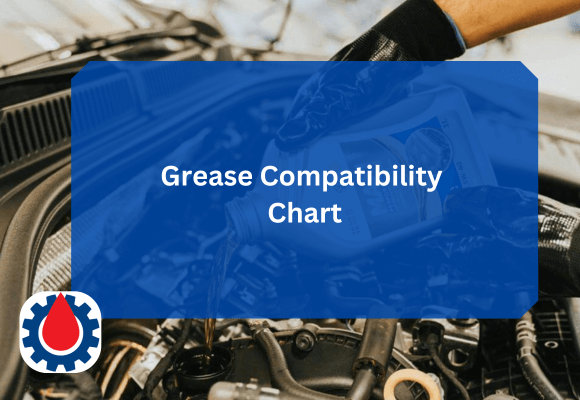Grease is one of the most important lubricants in machinery maintenance. It provides a protective layer that reduces friction, prevents wear, and protects equipment from contaminants like dust, water, and chemicals. However, not all greases are created equal, and mixing incompatible greases can lead to lubrication failure, equipment breakdown, and costly repairs. That’s where the grease compatibility chart comes in.
This guide explains grease compatibility, why it matters, and provides a comprehensive compatibility chart in a clear table format.
Grease Compatibility Chart
| Thickener Type | Aluminum Complex | Barium Complex | Bentonite Clay | Calcium | Calcium Complex | Calcium Sulfonate | Lithium | Lithium Complex | Polyurea | Sodium | Anhydrous Calcium | Silicone | Molybdenum Complex |
|---|---|---|---|---|---|---|---|---|---|---|---|---|---|
| Aluminum Complex | C | P | I | P | C | C | C | C | P | I | P | I | C |
| Barium Complex | P | C | I | P | P | C | C | C | P | I | P | I | P |
| Bentonite Clay | I | I | C | I | I | I | I | I | I | I | I | C | I |
| Calcium | P | P | I | C | C | C | C | C | P | I | C | I | P |
| Calcium Complex | C | P | I | C | C | C | C | C | P | I | C | I | C |
| Calcium Sulfonate | C | C | I | C | C | C | C | C | P | I | C | I | C |
| Lithium | C | C | I | C | C | C | C | C | P | I | C | I | C |
| Lithium Complex | C | C | I | C | C | C | C | C | P | I | C | I | C |
| Polyurea | P | P | I | P | P | P | P | P | C | I | P | I | P |
| Sodium | I | I | I | I | I | I | I | I | I | C | I | I | I |
| Anhydrous Calcium | P | P | I | C | C | C | C | C | P | I | C | I | P |
| Silicone | I | I | C | I | I | I | I | I | I | I | I | C | I |
| Molybdenum Complex | C | P | I | P | C | C | C | C | P | I | P | I | C |
Key: C = Compatible, I = Incompatible, P = Partially Compatible
Related Oil Drain Plug Torque Chart(For ALL Car Models)
Key Insights from the Compatibility Chart
- Lithium and Lithium Complex greases – Among the most widely used and generally compatible with many other thickeners, except bentonite and sodium.
- Calcium and Calcium Complex greases – Good compatibility with lithium types and each other.
- Calcium Sulfonate greases – Highly versatile and compatible with most, making them an excellent upgrade option.
- Polyurea greases – Often used in electric motor bearings, but show borderline compatibility with most. Switching requires a complete purge.
- Bentonite Clay greases – Inorganic thickener that is incompatible with nearly all others. Must not be mixed.
- Sodium greases – Rare today due to poor water resistance and very limited compatibility.
Related How to Get Engine Oil Out of Clothes(6 Proven Methods)
Best Practices for Switching Greases
Even if two greases are listed as “compatible,” it’s always best to follow these practices when changing:
- Check OEM recommendations – Always prioritize manufacturer guidance.
- Flush old grease – Clean the bearing housing and remove as much old grease as possible.
- Purge with new grease – Pump new grease until only clean lubricant is visible.
- Monitor closely – Watch operating temperature, noise, and bearing condition during the first weeks after a switch.
- Avoid mixing in storage – Store grease in labeled containers and keep dispensing equipment dedicated to one type.
Common Problems from Mixing Incompatible Greases
- Excessive heat generation – caused by thickener breakdown.
- Grease bleeding or hardening – loss of proper lubrication film.
- Increased wear or pitting – due to insufficient lubrication.
- Bearing seizure – in severe cases, can lead to catastrophic equipment failure.
Related Perkins Engine Torque Chart(For All Models/Series)
Why Grease Compatibility Matters
Grease is made up of three main components:
- Base oil – the primary lubricant.
- Thickener – holds the oil in place (e.g., lithium, calcium, polyurea).
- Additives – enhance performance (anti-wear, rust inhibitors, extreme pressure agents).
When greases with different thickeners are mixed, they can react negatively, causing problems such as:
- Hardening or softening of the grease.
- Oil separation, reducing lubrication.
- Reduced water resistance or corrosion protection.
- Shortened bearing life and unexpected downtime.
That’s why manufacturers strongly advise against mixing greases unless compatibility is confirmed.
Related Farmall H Engine Oil Capacity(+ Best Recommended Oils)
FAQs
How do you know if grease is compatible?
The easiest way to know if two greases are compatible is by checking a grease compatibility chart. These charts compare thickener types (such as lithium, calcium, polyurea, or bentonite) and show whether they can mix. If the chart shows “incompatible,” you should avoid mixing them.
What types of grease do not mix?
Greases thickened with bentonite clay or sodium are the most incompatible and generally do not mix with any other type. Even when greases seem similar, different additive packages can still cause problems, so it’s safest not to mix unless confirmed by the compatibility chart.
Can you mix different types of grease?
In most cases, you should avoid mixing different types of grease. While some greases like lithium and calcium-based types are more forgiving, others may cause hardening, oil separation, or bearing damage. Always flush out the old grease before introducing a new one.
What happens if you mix old grease with new grease?
Mixing old and new grease can dilute performance. Old grease may already be oxidized, contaminated, or degraded, which can weaken the protective properties of the fresh grease. This often leads to overheating, excess wear, or shorter bearing life.
Can I mix red grease with black grease?
The color of grease (red, black, blue, etc.) does not determine compatibility. Colors are simply dyes added by the manufacturer. What matters is the thickener type and base oil. Always check the compatibility chart instead of relying on color.
What is type Y grease?
Type Y grease is a specialized grease classification, often used in aerospace and military applications, designed for high-performance environments with strict specifications. It typically offers excellent resistance to oxidation, corrosion, and extreme temperatures, but it should only be used where specifically recommended.




